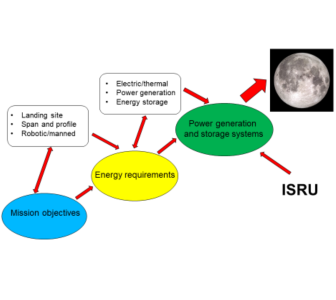Lunar ISRU Energy Storage and Electricity Generation (LIESEG)

Humankind tested its capacity to survive on the Moon’s surface for short periods of time through the Apollo missions almost 50 years ago. Since then, robotic missions to the Moon have spent periods lasting several days and nights on the satellite. However, many technological challenges arise when planning a lunar (robotic and/or manned) mission that is fully operational during the night. Among these challenges, the need for a power supply system for both day and night remains open.
The illustration figure shows the relationship between the mission objectives, energy requirements and power generation and storage systems for missions to the Moon. The energy requirements (which can be thermal and/or electrical) of a lunar mission are determined by several factors, including the landing site, lunar environment, span and profile of the mission, and whether it is robotic and/or manned. The energy requirements include the need for both power generation and storage. There are several technological candidates for these two functions.
This project focused on those technologies that can make use of in-situ resources (ISRU). The aim of this part of the project lied in finding one or more reliable systems that could provide the required power during both lunar day and night using solar energy and materials found on the Moon to store heat. The selected system(s) were analysed via computational studies over the course of the project.
